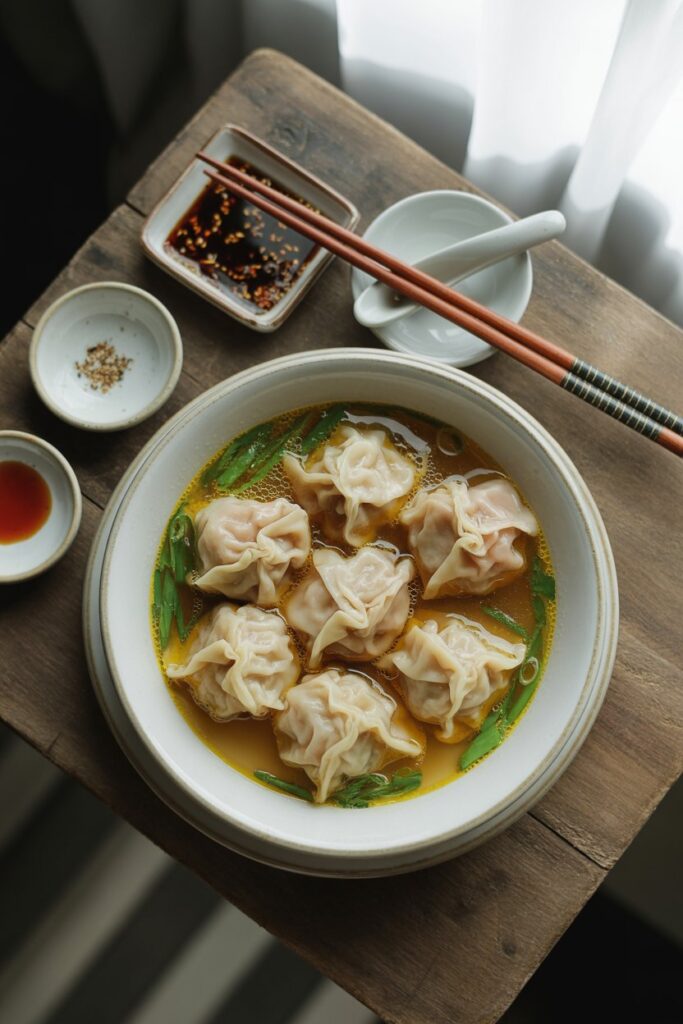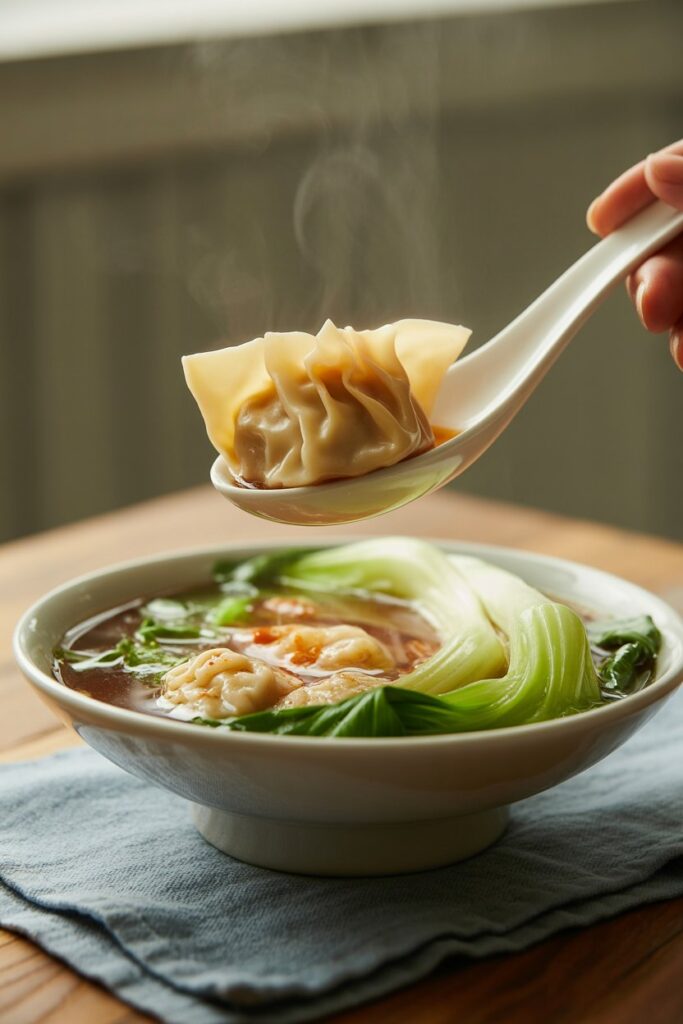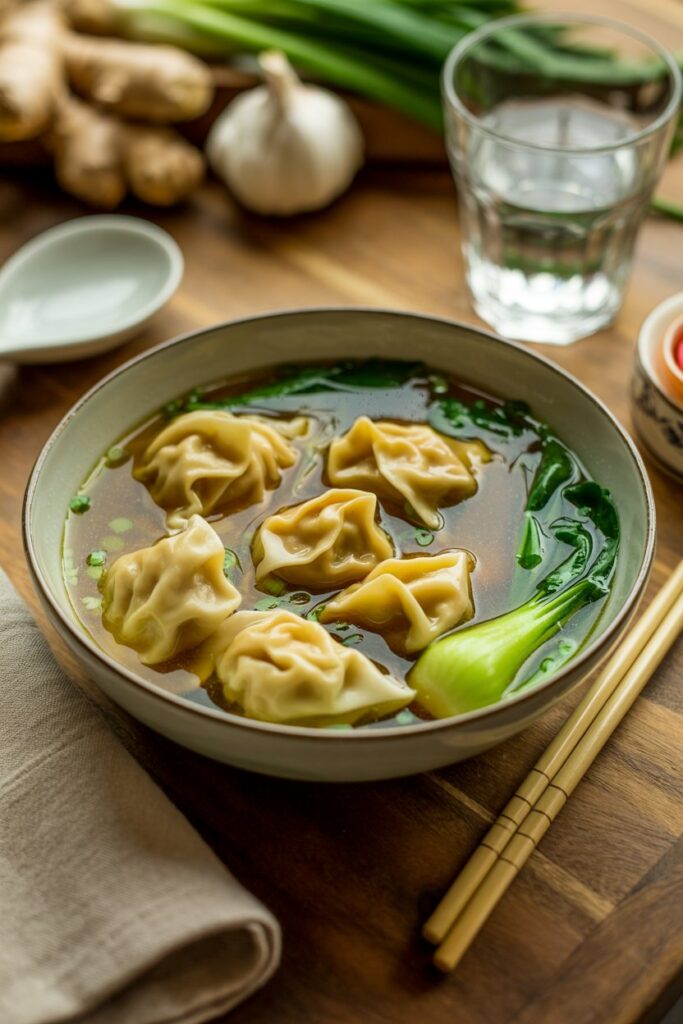There are few dishes that evoke the same sense of comfort, warmth, and satisfaction as a bowl of steaming wonton soup. It’s not just about the soft, delicate wontons, or the savory broth—it’s about the experience of each bite. The way the broth embraces the dumplings like a warm hug, or the slight pop of flavor when you bite into the tender filling. Wonton soup is a universal favorite, enjoyed across many cultures, but there’s an art to making it right.
Whether you’re a seasoned chef or a passionate home cook, this wonton soup recipe will elevate your skills and leave you with a deep appreciation for the simple, yet profoundly flavorful, dish. Let’s dive into the nuances of making this soul-satisfying soup.
What Makes Wonton Soup Special?
Wonton soup is a rich, flavorful dish that hails from the heart of Chinese cuisine. Its simplicity is what makes it so special. You’ve got a delicate broth, tender dumplings, and often a few garnishes for texture and color. But behind that simplicity is a harmony of flavors and techniques. It’s comfort food, but it’s also sophisticated, with layers of umami and warmth. The secret is in the balance—too much of one ingredient, and the whole soup can feel off.
Wonton soup isn’t just a dish; it’s a part of cultural tradition. In Chinese culture, wontons symbolize prosperity and good fortune, making them a popular choice for festive occasions like the Lunar New Year. But the soup transcends cultural boundaries, finding its way onto menus and dinner tables across the globe.
Wonton Soup Ingredients & Substitutions

You’ll notice that the ingredients for wonton soup are few, but each one plays a crucial role. Let’s break it down:
- Wonton wrappers: Thin, delicate, and slightly chewy, these are essential for the perfect dumpling. If you can’t find them, you can substitute with egg roll wrappers, though the texture won’t be the same.
- Ground pork: Traditional wonton filling often uses pork for its rich, fatty texture. If you’re not a fan of pork, chicken or shrimp make great alternatives.
- Ginger and garlic: These aromatics are the backbone of any good wonton filling. Fresh ginger is preferable for its sharp, peppery notes, but ground ginger can work in a pinch. Garlic adds the savory depth, so don’t skimp on it.
- Soy sauce: A splash of soy sauce deepens the savory flavor of the broth and the filling. You can substitute with tamari for a gluten-free option.
- Sesame oil: It’s all about that nutty, aromatic finish. A small drizzle goes a long way in creating the signature flavor.
- Broth (chicken or pork): The base of your soup. You can use store-bought broth, but homemade broth always adds that extra richness. If you’re vegetarian, vegetable broth can work too.
- Green onions: Fresh, crispy, and fragrant—green onions are the garnish you need for color and a pop of flavor.
- Bok choy (optional): A little greenery to add texture and balance the richness of the soup. It’s also a nice touch for presentation.
For dietary restrictions, you can easily swap ingredients. If you’re gluten-free, use gluten-free wonton wrappers and tamari instead of soy sauce. For those avoiding pork, as mentioned, chicken or shrimp are good options. Vegan? Replace the meat with tofu and add a little extra umami with mushrooms or tempeh.
Read this Blog: https://noshcrafters.com/ooey-gooey-butter-cake/
Step-by-Step Instructions

1. Preparing the Wontons
Start by making your filling. In a bowl, combine ground pork, a finely grated piece of ginger, minced garlic, soy sauce, sesame oil, and a pinch of white pepper. Mix it until it’s smooth. You want the filling to be sticky, so it holds well in the wrapper.
Here’s a common mistake: Don’t overfill the wrappers. If you pack them too tightly, they’ll burst open during cooking. Just a small teaspoon of filling in the center is all you need. Wet the edges of the wrapper with a little water, fold it over, and press to seal. It’s about finesse, not speed. If your wontons aren’t sealed well, they’ll open up in the broth and make a mess.
Once you’ve made all your wontons, set them aside.
2. Preparing the Broth
For the broth, bring your chosen stock to a boil. Add a splash of soy sauce, a dash of sesame oil, and some freshly grated ginger for that sharp, aromatic kick. Let it simmer for about 10 minutes. This isn’t just any broth—it’s the soul of the dish. Take your time to let the flavors meld together.
A common mistake I see is rushing the broth. The key to a good broth is allowing it to develop. You should taste it before you add any salt. The soy sauce should already give it enough depth, so you’re just adjusting for balance.
3. Cooking the Wontons
Bring a large pot of water to a boil, and carefully drop your wontons into the water. Don’t crowd them, or they’ll stick together. Gently stir to ensure they don’t stick to the bottom. After 4-5 minutes, the wontons will float to the surface. That’s your signal they’re ready.
At this point, you can add them directly to your prepared broth. The broth should be hot, but don’t boil it once the wontons are in—this can cause the wrappers to fall apart. Gently simmer the wontons in the broth for about 3-5 minutes, allowing the flavors to meld.
Cooking Technique & Science: Why Does This Work?
The magic in wonton soup lies in the way the broth and wontons interact. The broth infuses the wontons with flavor as they cook, while the dumplings release their savory juices back into the soup. This creates a symbiotic relationship where the filling and the broth elevate each other.
Also, there’s a reason we cook the wontons in a separate pot of water before adding them to the broth. This helps set the wrappers, so they don’t break apart in the hot liquid of the broth. Plus, it helps the wontons cook evenly, which is key to maintaining that delicate texture.
Serving & Pairing Suggestions

Once your wontons are cooked, ladle the broth into bowls, place a few wontons in each, and garnish with chopped green onions and a few leaves of bok choy. For a little extra flavor, drizzle a drop of sesame oil on top just before serving. You can serve your wonton soup with a side of rice or a simple vegetable stir-fry for a complete meal.
Pairing-wise, a light white wine like a Sauvignon Blanc or a crisp beer can complement the freshness of the wontons and the richness of the broth.
Conclusion: The Key Takeaways
Wonton soup is deceptively simple but demands a keen attention to detail. From the selection of ingredients to the delicate folding of each wonton, it’s a dish that rewards patience and precision. The broth should be rich and savory, the wontons tender yet firm, and the garnish fresh and aromatic. If you get these elements right, you’ll have a bowl of wonton soup that’s truly something special.
Expert Tips & Troubleshooting
- If your wontons aren’t sealing properly, it could be because you’re not wetting the edges enough. Don’t skimp on the water—it helps form a strong seal.
- If your broth turns out too salty, try adding a little more water and simmering it longer to balance out the flavors.
- For extra richness, use homemade broth instead of store-bought. It’s time-consuming, but the result is worth it.
Frequently Asked Questions
Can I make wontons ahead of time?
Absolutely! You can make and freeze wontons for up to a month. Just cook them directly from frozen—no need to thaw.
Can I use a different meat for the filling?
Yes! Ground chicken, beef, or even shrimp can be substituted for pork.
What’s the secret to a great broth?
Simmer it slowly, and don’t rush. Add a little ginger and soy sauce for depth, but let the stock do the heavy lifting.
Can I make wonton soup vegetarian?
Yes! Use tofu or mushrooms in place of the meat for a tasty vegetarian option.

Food lover, recipe creator & the heart behind NoshCrafters.com. Olivia shares mouthwatering, easy-to-make dishes that turn everyday meals into unforgettable bites. When she’s not experimenting in the kitchen, she’s busy plating up inspiration for home cooks everywhere.